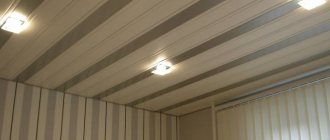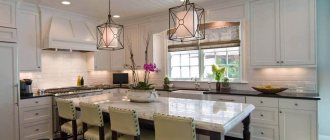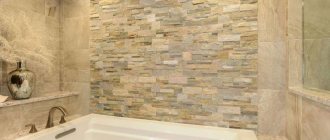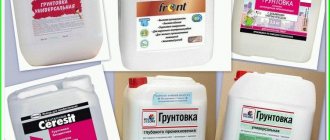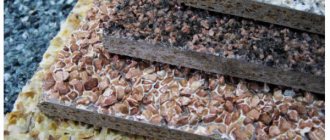Requirements for panels for finishing walls and kitchen splashbacks
The main function of an apron is protective. Many different processes are constantly taking place on the kitchen surface. Frequent use of any type of slab leads to the wall gradually beginning to collapse. Elevated temperatures have a detrimental effect on plaster.
Moisture also has a rather negative effect on the wall surface. This is, in fact, the most dangerous factor. Based on this, several basic requirements for panels should be highlighted:
- the material must not allow moisture to pass through;
- the surface of the panels must be of sufficient quality so that it can be washed using any cleaning agents;
- the material should not change its appearance and characteristics under various mechanical influences;
- panels must maintain their functionality during sudden temperature changes;
- the appearance of products made from various types of materials should match the design of the kitchen as harmoniously as possible.
What should an apron be like?
An apron, as an interior element, not only decorates the space between kitchen cabinets.
It is designed to protect walls from liquid, grease, dirt and soot. In order for the coating to fulfill its function, it must be made practical, easy to clean, resistant to high temperatures and chemical detergents. The wall cladding near the work surface should have a pleasant appearance.
Nowadays, aprons are made of ceramic tiles, mosaics or glass. For those who want to make a renovation that will last forever, cladding made of natural stone, metal or brick is suitable.
Advantages of wall panels
When renovating your kitchen, you should definitely pay attention to special wall panels. They can be either whole or consist of small fragments. The abundance of colors allows you to choose the most suitable option for any style of furniture.
Basically, these panels have standard sizes ranging from 40-65 cm between the countertop and cabinets. But each individual case requires individual measurements. Therefore, the majority of manufacturers adjust the dimensions to the characteristics of the client’s kitchen.
The advantages of wall panels in the kitchen include the following points:
- Attaching the kitchen panel is quite simple and does not take much time.
- In addition to its protective functions, the material acts as an additional soundproofing layer.
- The solid design allows you to hide any flaws and unevenness of the wall.
- The products help complement the spectacular design of the kitchen and create a cozy atmosphere.
Options for work wall
Plain
MDF aprons are incredibly varied in their color scheme. Single-color options are produced in a wide range and are suitable for both light and black interiors, bright and pastel, matte and glossy. You can choose a panel that exactly matches the kitchen unit, opt for a contrasting solution, or purchase an apron that is just 1-2 shades lighter/darker than the existing furniture. Read our tips on how to choose an apron for a white kitchen at this link.
Colored
A one-color solution is not for you? Pay attention to the colored aprons. Panels with imitation wood, cork, stone, parquet boards, ceramic tiles... The range is limitless
At the same time, there is no point in choosing a panel according to the principle “dark colors show less dirt,” because the MDF surface of any shade can be easily washed with water.
Photo printing or artistic drawing
This option is suitable for connoisseurs of non-standard solutions. A real painting will appear in the kitchen area, a canvas that will become a bright accent. You can choose panels with floral patterns, panoramas of metropolises, still life, picturesque landscapes of mountainous areas, or one of hundreds of thousands of other options. Read how to choose an apron for a white kitchen with a black countertop in this material.
For an interior decorated in red and black shades, a Japanese-style panel, options with imitation animal skins, black and white panels, white panels with large photographs of red berries, etc. would be acceptable.
For a kitchen in soft colors and with floral wallpaper, panels depicting fruits, a spring meadow, and bright butterflies would be appropriate.
Types of wall panels
To equip the space in the kitchen, a wide variety of materials are used. They all differ from each other in performance characteristics, sizes, and resistance to physical and chemical influences.
Among all the proposals, there are samples that are more popular and less popular. The most common types of materials include the following samples:
- MDF panels;
- PVC panels;
- plastic products;
- tile;
- mosaic;
- glass.
These materials are used more often than other varieties because they are considered reliable and proven. You can always find a suitable product at a reasonable price.
You can install wall panels of various sizes and shapes. The second criterion should also be divided into three types:
- rack and pinion;
- sheet;
- tiled.
What is a false panel: materials of manufacture
A false panel is a decorative plate that can be made from various materials. In terms of their texture and shades, false panels for the kitchen are no different from ordinary wall decoration.
Are fittings or pipe remains sticking out of the wall? The fittings will help you hide all the imperfections
Purposes of false panels:
- Leveling surfaces;
- Masking of any defects on the walls, as well as various voids and large cracks;
- Improvement of unsightly areas between adjacent cabinets;
- Masking of pipes and electrical wiring;
- Participation in lighting design.
Materials for false panels:
- Natural wood. The most environmentally friendly material that can be used in decorating a kitchen in a classic or country style. The disadvantage of the material is the high cost and fear of high humidity.
- Chipboard. One of the most popular materials in use. It has a wide selection of colors, reasonable prices and good moisture resistance. The installation of such panels is quite simple; you can do the installation yourself.
- PVC. The most practical material, famous for its fireproof and waterproof qualities. Dirt practically does not accumulate on the smooth surface, which is suitable for decoration anywhere in the kitchen. The material has a relatively low cost and has a wide selection of colors, which is an ideal option for kitchen installation.
- Stone. False panels decorated with stone are used for spacious rooms with a rich interior. Such material will not cost you cheap and is usually installed in certain areas of the kitchen. However, artificial or natural stones give the room both coziness and luxury, which is perfect for a modern kitchen.
Related article: How to take and read electricity meter readings
The most versatile option is a false chipboard panel: it will fit into any design style
In addition to basic materials, many designers use plexiglass, metal mosaics or mirror elements to decorate false panels. But for such decorations, a strong and high-quality base must first be installed. The scope of application of such panels is practically unlimited; they can be used anywhere and for any purpose, as long as the material allows it.
Fastener selection
A kitchen apron can be mounted in a variety of ways. Here are some basic fastening materials.
Glue
The first and most common type of material is special glue. It is designed to dry quickly and withstand large and heavy structures. It is not difficult to install panels on high-quality liquid nails. Proper distribution of the sheathing and accurate measurements will create a durable structure.
Self-tapping screws and nails
The second most popular fastening device is a screw. Moreover, the installation of a kitchen apron is carried out using hardware of various sizes. It all depends on the selected panel. Wood screws are often used. They are strong enough to support the weight of any kitchen backsplash.
Special profiles
When it comes to MDF panels and some plastic sheets, you can resort to another high-quality fastening - a profile. It helps level the wall, creating a little extra space behind the backsplash. Thanks to the use of a reliable aluminum profile, you can forget about kitchen renovation for a long time.
Method of attaching panels in a small kitchen
If installing panels on a frame does not suit you, you can glue the products directly to the walls. True, this method will require ideal smoothness and evenness of the walls, but it will be optimal for a small kitchen. In order to glue the products, you do not need wooden slats, a drill or screws. All you need is panels and glue.
- Such installation will require constant checking of the horizontal level and maximum accuracy.
- You need to glue the panels using a roller or spatula, and after completing the process, you should check the neatness of the seams, and then wipe the wall covering with a damp sponge.
- All unsightly parts of the panels should be hidden behind the cabinets. Calculate their location so that the last and upper sections are “hidden” behind the elements of the kitchen set.
It is worth saying that it is worth gluing the panels when you are sure that the hood and ventilation work well in your kitchen, since over time the products can “move away” from the walls due to constant changes in humidity and temperature.
If you are making temporary repairs and plan to change the situation in the future, the option of attaching with glue is suitable. In the photo below you can see what the process of such an installation with glue looks like.
Experts recommend installing panels on a frame - this method is more reliable and does not require perfect walls. But adhesive mounting is suitable for those who need to install the panels as quickly and easily as possible.
As a rule, installation with glue is carried out in new houses, where the final preparation of the walls has already been completed, but the occupant has not yet set foot.
Stages and technology of panel installation
The whole process is divided into the following stages:
- Preparation.
- Installation of sheathing.
- Fastening.
- Checking and correcting errors.
Following these steps is imperative because they will minimize waste. Fasteners for any kitchen apron are a component that you should not skimp on.
Surface preparation
Initially, the wall needs to be leveled. This is done in order not to resort to the use of additional parts when creating the sheathing. It is better to mount the panels on a flat wall.
After this, they begin to treat the surface with a primer.
The desired area is measured with a tape measure.
The last step of this stage is the design of various communications that will need to be carried out, and additional treatment with antifungal compounds.
Frame structure
A reliable structure is a frame that is rigidly fixed to the wall. It should consist of beams and strong planks. It will be enough to build a primitive quadrangular frame, which will serve as a reliable basis for the apron. Experienced specialists design and complete the sheathing in half an hour.
Subtleties of panel fastening
As with any other process, installing an apron has its own characteristics.
Attention! Attaching a wall panel in different kitchens requires following certain rules for handling materials.
For example, to create an adhesive base for tiles, mosaics or plastic, it is better to use a special mixer-type attachment. It will also be convenient for mixing plaster for wall treatment.
When laying tiles, you will need a professional cutter. The installation of various wall panels to the wall must be approached responsibly, so you should use a good tape measure and high-quality mounting tools.
Final installation of corners and skirting boards
The last stage is the design of the entire structure. You can resort to different finishing methods, but the most common is the use of neat corners attached at the junction of the panels with the surfaces of the kitchen furniture. After installing all the fragments, the baseboards are secured using liquid nails.
Stage 3 – assembling the frame
There is an important point to be made here. Before you fasten the slats, treat them with moisture-proof impregnation. When you plan repairs and purchase consumables, purchase such a product in the store. Impregnation will extend the life of the frame and protect the wood from swelling and deformation. So, you have already calculated the length of the slats and their number.
Let's start installing the frame with our own hands.
- Cut the wooden planks with a hacksaw.
- Take the slats that will be installed around the perimeter. Using a hammer drill and self-tapping screws, attach them to the wall. Remember that each vertical rail must be adjusted and checked for level with a tape measure.
- We continue the installation and insert jumpers. No need to screw it in yet.
- We take the construction thread and stretch it from the right batten to the left. This way you will understand where to fix the jumpers in order to get an even frame for the wall panel.
- Now you can screw the jumpers.
So you have assembled the frame for the panels with your own hands. In the next photo you can see what a structure made of wooden slats looks like.
Also during the installation process, the video at the end of the article will help you, where experienced craftsmen show you step by step the entire process of installing the frame. If this is your first time renovating, every piece of advice will be valuable.
Self-installation of a kitchen apron
To fasten products yourself, you need to acquire tools and some skills.
In fact, the installation process is simple and only requires attention. Firstly, it is the correct measurements of the wall and determination of the panel dimensions. Whether it is a solid structure or individual sheets, you can install any option yourself.
After the panel option is selected, you need to check the wall to see how smooth it is. Then follows the stage of creating the sheathing and marking the position of the sheets.
It is better to ask someone to help, because it will be very difficult to attach long sections with your own efforts.
Important! Using a building level is a critical factor.
If a profile is used, it is secured with nails. Wood screws are also used. It will be possible to mount a finished panel to it. Fastening with liquid nails is allowed.
If you have ever made a kitchen apron yourself, share your successes or tell us about your mistakes in the comments.
Did you manage to solve your problem using the recommendations from the article?
Yes!
46.06%
No. More answers required. I'll ask in the comments now.
37.9%
Partially. There are still questions. I'll write in the comments now.
16.03%
Voted: 343
How to mount it on the wall?
It is quite possible to install a kitchen apron yourself. Let's take a look at several ways to secure this finish.
On the guides
As mentioned above, a plastic kitchen apron is inexpensive. That is why such finishing is often replaced as soon as the old one becomes boring. If you assume that over time you will want to install new plastic parts, then you should install them on the wall using guides, which are metal slats.
The guides must be attached to the walls using self-tapping screws. Plastic panels are simply attached to these guides like rails. If necessary, they can be pulled out and new elements installed.
Self-tapping screws
If you want to install a plastic kitchen apron thoroughly and do not intend to replace it in the near future, then you should turn to securing it with self-tapping screws. You can drill right through the plastic without any problems. But you need to take into account that for this installation method you will need to prepare the walls - they must be perfectly smooth, without potholes or drops. Do not be afraid of marks from self-tapping screws that appear on plastic decorative coverings. If desired, they can be easily and quickly closed using special color-matched plugs.
With this method of fastening, the plastic apron will not fit tightly to the wall base. There will be a small free space behind this part. Many craftsmen hide unattractive electrical wiring there, making the interior more aesthetically pleasing and neat. In addition, the apron installed on self-tapping screws can also be easily removed whenever you want.
On the sheathing
This is another popular way to install a plastic splashback. It should only be used if the kitchen area is not too small. Many users prefer not to waste time by installing the apron directly on the rough base of the wall, but here you can encounter significant unevenness. In this case, installing the sheathing can save the situation.
The lathing is a set of metal slats or wooden blocks that are attached to the wall base along the perimeter of the future kitchen apron. First, a kind of square is formed on the wall, which has the same dimensions as the plastic part. After this, vertical and horizontal strips are installed inside this square using self-tapping screws. These parts are needed to make the structure stronger and more reliable. A plastic panel is also attached to the resulting sheathing using self-tapping screws. In this case, there will be a small free space between the apron and the wall, where it will be possible to place electrical wiring or build beautiful lighting.
Preparatory work
If a complete kitchen renovation has been carried out, this means that the wall is completely ready for installing an apron. If the issue is only a replacement, then it is necessary to prepare the wall area.
Old finishing materials, protruding nails, screws, etc. are completely removed, surface defects (cracks, chips and gouges) are repaired, the wall is partially leveled with putty and, after complete drying, treated with an antiseptic solution.
Advice! Be sure to install a mounting strip under the future apron. This can be a regular wooden lath or a metal profile for drywall. It is attached with self-tapping screws to the wall under the lower edge of the apron. A prerequisite is the horizontal position of the profile.
This mounting strip is both a support on which the MDF is installed and a reference point for installation. After installation is complete, this strip can be dismantled.
Installation of an MDF apron
Why is it worth using PVC panels for covering an apron?
To increase the service life of kitchen panels, stabilizers are added to their composition. These are chemical elements in bound form. They are absolutely safe for the environment and humans. At the same time, the material does not ignite and does not support combustion. But this is far from the only reason. PVC panels are chosen because:
- with them, repairs are carried out quickly and without unnecessary dirt;
- they can be installed on unprepared walls;
- they are not afraid of water and are easy to care for;
- the stores have a large selection of panels with different decorative properties;
- material price is available.
Choosing an apron: useful tips
Before purchasing or ordering a product, you need to consider a few points:
- The edges of the apron should extend beyond the kitchen unit, so you need to take all the measurements first.
- To prevent water flowing from the countertop from getting under the product, it is recommended to install a border for the joints, the purpose of which is to prevent the penetration of moisture.
- For small rooms, the best choice would be a white kitchen apron that matches the overall design of the kitchen. You can choose a light-colored product decorated with a discreet pattern.
- Covering a wall with a small backsplash with an image printed by the manufacturer using heat printing is a bad idea because it will not be noticeable.
Features of a plastic apron
Depending on the type of coating, the service life of a plastic apron is usually no more than 3-5 years. You can find different types of products on sale, but to decorate the kitchen work area, it is best to choose monolithic polycarbonate sheets.
Of all types of plastic, polycarbonate is the most wear-resistant. In appearance it resembles glass, however, despite its visual fragility, it is the strongest of all polymers existing on the world market.
Benefits of use
In addition to the fact that plastic is one of the most budget-friendly materials, it also has some other undeniable advantages.
Among them we can especially highlight:
- light weight;
- hygiene;
- moisture resistance;
- wide range of decorative patterns and colors.
An undoubted advantage is also the ability to apply your own unique image to the surface of the selected material.
Flaws
In order not to be disappointed in the purchase, you must also carefully consider the main disadvantages of the plastic coating.
These include, first of all,:
- low resistance to scratches and mechanical damage;
- tendency to fade, especially with prolonged exposure to direct sunlight;
- low fire resistance;
- high sensitivity to aggressive detergents.
We must also not forget that panels made on the basis of polyvinyl chloride are an artificial material, so before purchasing you must pay attention to the availability of certificates. Products of dubious quality may contain components hazardous to health.
How to fix installation errors
During use, the apron may lose its original appearance. What to do if a beautiful kitchen decor is swollen, how to fix the damage? First of all, find the reason. This usually happens with panels near the seams. During work, all seams must be treated with sealant, then moisture will not get under the apron and will not be able to deform it.
If a problem does occur, remove the damaged strip and inspect the frame. Perhaps this is the reason. Wooden sheathing strips can become deformed, which leads to deformation of the apron. This can be corrected by replacing damaged elements.
Sometimes a kitchen apron loses its brightness. Nothing can be done about this. PVC panels should not be washed using abrasive substances. If the design has become faded and ugly, but you are not ready to change the kitchen apron, decorate its surface with self-adhesive film. It is inexpensive, and the choice of colors will please you.
What is a plastic apron?
A plastic apron is made from polymer materials such as polycarbonate or polyvinyl chloride (PVC).
Despite the relatively low cost, light weight and flexible structure, a kitchen apron made of plastic is durable, able to withstand high temperatures (up to +120°C), and is not susceptible to the development of mold and the proliferation of microorganisms. There are 3 types of materials for an apron:
- Solid plastic sheets 1.5 cm thick and 60 cm high. The length of such plates can be 2-3 m. The product can be glossy or matte, has a smooth or structured surface, and is decorated with drawings and photo printing.
- PVC panels are produced with a thickness of no more than 1 cm, width varies from 15 to 50 cm, available lengths are 260, 270 and 300 cm. They are printed with designs and embossed to resemble wood, tiles, and mosaics.
- PVC lining - three-meter strips 10-12.5 cm wide, most often plain, in pastel colors.
Calculation of the width and height of the apron
The width of the apron depends on the size of the kitchen space. With height the situation is somewhat more complicated. This parameter is influenced by the following factors:
- the distance between the lower and upper tier of the headset. The height of this gap is most often no more than 112 cm;
- the presence of a domed independent hood - in this place the apron is laid out at a higher height, and if a skinali is used, the hood itself should be placed at a lower height;
- design features of the upper cabinets - if the facades are equipped with lifting mechanisms, a low apron with dimensions of 45-55 cm looks great.
Types of decorative coating for MDF panels
MDF is made by pressing wood chips with an adhesive composition. The resulting slab is subjected to further decorative finishing using various technologies. The result is: laminated, painted, laminated, veneered MDF boards.
Laminated coating is made by treating panels with PVC film or melamine paper. Laminated MDF panels can withstand various adverse influences without damage. They are used in furniture production, including for making kitchen facades.
MDF panels are also painted. And then they make furniture for bathrooms or kitchens. However, painted panels have a significant drawback: such a coating does not withstand temperature and mechanical factors.
Gluing plastic to a panel is called laminating. Such a panel becomes more moisture-resistant, wear-resistant and temperature-resistant. Due to their practicality, such panels are often used to make kitchen splashbacks and other kitchen elements.
By veneering MDF panels, they acquire the appearance of natural wood.
There is another way to decorate MDF panels. This is the application of various drawings and photographs to the surface using photo printing. Such panels are called skinali. Initially they were made of glass. Skinals are very popular and are used to decorate kitchen aprons.






